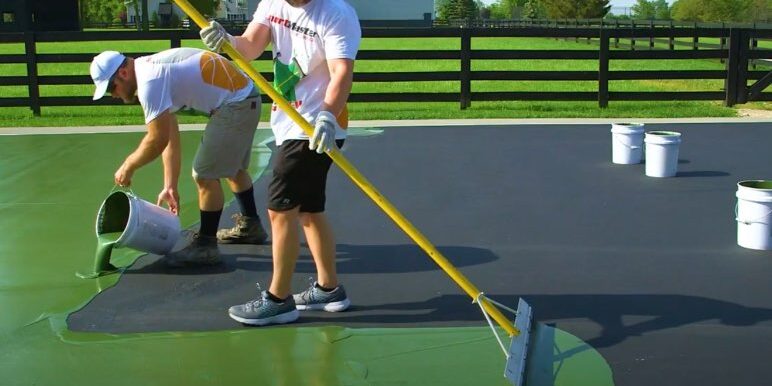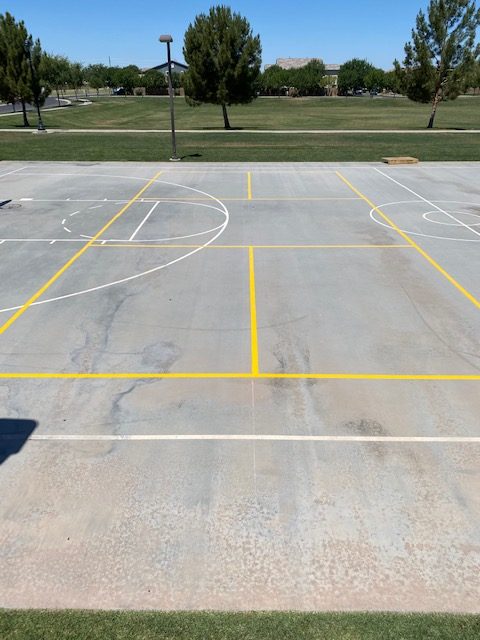A Comprehensive Guide to Creating the Perfect Pickleball Court for All Ability Levels
Creating a pickleball court that caters to gamers of differing skill degrees demands a complex strategy, incorporating essential aspects such as court dimensions, surface area products, and access features. What specific factors to consider must be focused on to make sure a successful application?

Comprehending Court Dimensions
Understanding the measurements of a pickleball court is crucial for both developers and gamers, as these specifications make sure a reasonable and constant having fun experience. A typical pickleball court gauges 20 feet large by 44 feet long for both singles and doubles play. The court is separated into two equivalent fifty percents by a web that stands 36 inches high at the sidelines and 34 inches at the center.
Secret functions of the court include the non-volley zone, typically described as the "kitchen," which expands 7 feet from the internet on both sides. This location is important for managing player movement and volleying, making sure strategic play. Furthermore, the solution areas on each side of the court are important, determining 10 feet broad and 15 feet deep, developed to fit correct serving methods.
Bordering the court, a location of at the very least 10 feet ought to be assigned as the safety and security area, allowing players adequate space to move and stop injuries throughout play. Sticking to these dimensions not just cultivates reasonable competitors yet additionally advertises safety and pleasure for all participants, making it necessary for any kind of pickleball court layout.
Picking the Right Surface Area
The option of playing surface for a pickleball court dramatically influences the video game's characteristics and player experience. Choosing the appropriate product is crucial for guaranteeing player comfort, security, and performance. Common surfaces consist of asphalt, concrete, and specialized sports floor covering.
Asphalt is a preferred option due to its price and toughness. It provides a regular having fun surface area but can be tough on joints over prolonged play. Concrete, while comparable in resilience, uses minimal adaptability, potentially leading to raised effect on gamers' bodies.
For a more supported experience, many facilities go with specific sports flooring, such as synthetic surface areas or modular tiles. These materials usually include shock-absorbing buildings, reducing the danger of injuries and improving gamer convenience. Such surfaces can boost round bounce uniformity, which is crucial for fair play.
When picking a surface, think about aspects such as environment, maintenance requirements, and the intensity of play. An appropriate surface area not just improves gameplay however also contributes to the longevity of the court itself. Ultimately, understanding the nuances of different products will aid in creating an ideal pickleball environment tailored to various ability degrees.
Optimum Court Format
An ideal court format is crucial for taking full advantage of both player efficiency and spectator satisfaction in pickleball. The measurements of a common pickleball court are 20 feet wide by 44 feet long for doubles play, keeping a clear limit that enhances gameplay. The net, placed at 36 inches high at the sidelines and 34 inches in the facility, is essential for maintaining the dynamics of the video game.
Incorporating assigned locations around the court for players to move openly is important. A minimum of 10 feet of clearance on all sides of the court is advised to stop accidents and provide area for viewers. Furthermore, orientation plays a considerable duty; the court ought to preferably be straightened north-south to minimize the effect of sunlight glow on gamers throughout peak hours.
Visible and clear court markings help in gameplay, with contrasting shades for limits and non-volley zones that delineate crucial locations for players. On the whole, a well-designed court format promotes an engaging atmosphere for both gamers and viewers.

Access Considerations
When designing a pickleball court, making certain ease of access for all gamers, consisting of those with impairments, is extremely important. A thoughtfully made court can promote inclusivity and urge participation from individuals of differing abilities.

Access courses to the court have to also be carefully planned. Ensure that paths bring about the court are broad enough for wheelchair customers and are equipped with ramps where essential. Signage should be huge and clear enough to be quickly checked out.
Furthermore, seating locations must be created why not try these out to permit easy access to and from the court. This includes offering designated spaces for viewers that may have wheelchair difficulties.
Finally, guarantee that restroom centers nearby fulfill availability standards. By taking into consideration these aspects, you can create a pickleball court that rates and useful for everybody, therefore advertising a lively and varied community of players.
Maintenance and Maintenance
Appropriate upkeep and upkeep of a pickleball court are necessary for making certain optimal playing conditions and lengthening the lifespan of the facility. Routine assessments should be carried out to recognize and address any damages or put on, such as fractures in the surface or loosened netting. These problems, if left ignored, can negatively affect gameplay and security.
Surface maintenance is vital; courts must be cleaned up often to eliminate debris, leaves, or dirt that can affect traction. For hard courts, periodic pressure cleaning is advised to keep surface area honesty and aesthetics. If your court is made of softer products, such as asphalt, securing or resurfacing may be necessary to protect versus weather-related wear.
Furthermore, net elevation and tension ought to be checked on a regular basis, as improper settings can modify gameplay. Preserving surrounding locations, consisting of fencing and lights, is equally important for making certain a enjoyable and risk-free setting.
Conclusion
In conclusion, the design of a perfect pickleball court requires a precise approach that encompasses correct measurements, suitable surface area products, and thoughtful layout. By sticking to these guidelines, the perfect pickleball court can be created, promoting satisfaction and sports use this link development for gamers of varying ability levels.
Creating a pickleball court that caters to players of differing skill degrees necessitates a diverse approach, incorporating necessary aspects such as court dimensions, surface area products, and availability features.Recognizing the dimensions of a pickleball court is critical for both designers and gamers, as these requirements ensure a regular and fair playing experience.The choice of playing surface area for a pickleball court considerably affects the video game's dynamics and player experience.An optimal court design is important for taking full advantage of both gamer efficiency and viewer enjoyment in pickleball. By sticking to these guidelines, the best pickleball court can be developed, advertising enjoyment and athletic growth for gamers of differing ability degrees.